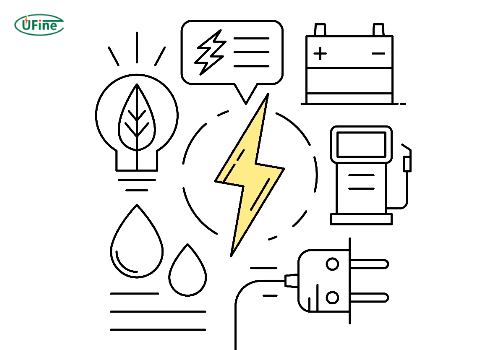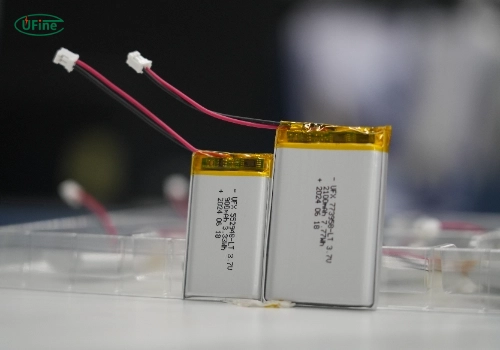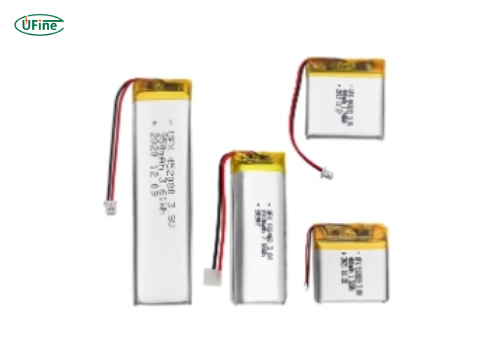
- Part 1. Understanding battery voltage basics
- Part 2. The 3.7V lithium-ion battery
- Part 3. The 3.8V lithium-ion battery
- Part 4. Critical differences between 3.7V and 3.8V batteries
- Part 5. 3.7V and 3.8V batteries performance comparison in real-world applications
- Part 6. Making the right choice: 3.7V or 3.8V?
- Part 7. FAQs
Battery technology determines performance, longevity, and overall user experience in portable electronics and mobile devices. Two standard battery voltages often come up in discussions: 3.7V and 3.8V. While these voltages may seem similar initially, some key differences can impact device performance and battery life. This comprehensive guide will explore the distinctions between 3.7V and 3.8V batteries, their applications, and what these differences mean for consumers and manufacturers alike.
Part 1. Understanding battery voltage basics
Before diving into the specifics of 3.7V and 3.8V batteries, it’s essential to understand what battery voltage means and how it affects device performance.
What is battery voltage?
Battery voltage refers to the electrical potential difference between a battery’s positive and negative terminals. It measures the force that drives electric current through a circuit. In simple terms, voltage determines how much “push” the battery can provide to power a device.
Nominal voltage vs. actual voltage
We commonly see voltage ratings (like 3.7V or 3.8V) as nominal voltages. The actual voltage of a lithium-ion battery can vary depending on its state of charge:
- A fully charged 3.7V battery might reach up to 4.2V
- A fully discharged 3.7V battery might drop to around 3.0V
- The nominal voltage represents an average or typical voltage during everyday use.
Artikel Terkait: Battery Nominal Voltage: What You Need to Know
Part 2. The 3.7V lithium-ion battery
The 3.7V lithium-ion battery has been a staple in portable electronics for many years. Let’s examine its characteristics and applications.
Critical features of 3.7V batteries:
- Nominal voltage: 3.7V
- Fully charged voltage: Typically 4.2V
- Cut-off voltage: Usually around 3.0V
- Everyday chemistry: Lithium Cobalt Oxide (LiCoO2) or Lithium Manganese Oxide (LiMn2O4)
Applications of 3.7V batteries:
Various consumer electronics, including, use 3.7V lithium-ion batteries extensively:
- Smartphones
- Tablets
- Digital cameras
- Portable speakers
- E-cigarettes
- Power banks
Advantages of 3.7V batteries:
- Wide availability: Due to their long-standing use in electronics, 3.7V batteries are readily available and compatible with many devices.
- Established technology: Manufacturers and consumers are familiar with the performance characteristics of 3.7V batteries.
- Cost-effective: The mature technology and widespread production make 3.7V batteries more affordable.
Part 3. The 3.8V lithium-ion battery
The 3.8V lithium-ion battery is a more recent development in battery technology, offering some advantages over its 3.7V counterpart.
Critical features of 3.8V batteries:
- Nominal voltage: 3.8V
- Fully charged voltage: Typically 4.35V or even 4.4V in some cases
- Cut-off voltage: Usually around 3.0V
- Everyday chemistry: Often uses advanced cathode materials or additives to enable higher voltage
Applications of 3.8V batteries:
More devices are increasingly using 3.8V batteries in:
- High-end smartphones
- Tablets with demanding power requirements
- Electric vehicles (as part of larger battery packs)
- Drones and other high-performance portable devices
Advantages of 3.8V batteries:
- Higher energy density: The slightly higher voltage allows more energy storage in the same physical size.
- Improved device performance: The higher voltage can provide more power to devices, potentially improving performance.
- Longer runtime: In some cases, the higher energy density can translate to more extended device battery life.
Part 4. Critical differences between 3.7V and 3.8V batteries
Now that we’ve explored the basics of both battery types let’s compare 3.7V and 3.8V batteries directly to understand their key differences.
1. Voltage range
- 3.7V battery: Typically charges to 4.2V and discharges to 3.0V
- 3.8V battery: Often charges to 4.35V or 4.4V and discharges to 3.0V
The higher charging voltage of 3.8V batteries allows for more energy storage. Still, it also puts more stress on the battery cells.
2. Energy density
- 3.8V batteries generally offer a higher energy density compared to 3.7V batteries. This means they can store more energy in the same physical size, potentially leading to longer device runtime or smaller battery sizes for the same capacity.
3. Device compatibility
- While many devices designed for 3.7V batteries can work with 3.8V batteries, it’s only sometimes guaranteed. Some devices may have voltage regulators or other components designed explicitly for 3.7V input, which could be affected by the higher voltage of a 3.8V battery.
4. Charging requirements
- 3.8V batteries typically require chargers capable of providing a higher voltage (4.35V or 4.4V) compared to standard 3.7V battery chargers (which usually offer 4.2V). Using the wrong charger can lead to undercharging or potential safety issues.
5. Lifespan
- The higher charging voltage of 3.8V batteries can lead to a shorter lifespan than 3.7V batteries. The increased stress on the battery chemistry during charging and discharging cycles may result in faster capacity degradation over time.
6. Safety considerations for 3.7V and 3.8V batteries
Overcharging risks:
- 3.7V batteries: Generally have well-established safety mechanisms to prevent overcharging beyond 4.2V.
- 3.8V batteries: These may require more sophisticated protection circuits to safely manage the higher charging voltages of 4.35V or 4.4V.
Thermal management:
- Higher-voltage batteries, like 3.8V cells, may generate more heat during charging and discharging, necessitating better device thermal management systems.
Protection circuits:
Both 3.7V and 3.8V batteries typically include protection circuits to prevent:
- Overcharging
- Over-discharging
- Short circuits
- Excessive current draw
However, the specific voltage thresholds for these protection mechanisms may differ between 3.7V and 3.8V batteries.
Part 5. 3.7V and 3.8V batteries performance comparison in real-world applications
To understand the practical differences, let’s examine how 3.7V and 3.8V batteries perform in some typical applications.
Smartphones:
- 3.7V batteries have been the standard for many years, offering reliable performance and compatibility with a wide range of charging accessories.
- 3.8V batteries: Increasingly used in high-end smartphones, potentially offering longer battery life or enabling slimmer device designs.
Drones:
- 3.7V batteries: Commonly used in smaller, consumer-grade drones.
- 3.8V batteries: Often preferred for high-performance or professional-grade drones due to their higher energy density, potentially extending flight times.
Electric vehicles:
- While individual cells in EV battery packs may use 3.7V or 3.8V nominal voltages, the entire battery pack design, rather than individual cell voltages, typically determines the overall impact on vehicle performance.
Part 6. Making the right choice: 3.7V or 3.8V?
When deciding between 3.7V and 3.8V batteries for a specific application or device, consider the following factors:
- Device compatibility: Ensure the device can safely operate with the chosen battery voltage.
- Performance requirements: Assess whether the potential benefits of a 3.8V battery (higher energy density, potentially longer runtime) are necessary for the application.
- Charging infrastructure: Consider whether existing chargers and power adapters are compatible with the chosen battery voltage.
- Cost considerations: Evaluate the price difference between 3.7V and 3.8V options, considering initial costs and potential long-term savings from improved performance.
- Expected device lifespan: The potentially shorter cycle life of 3.8V batteries may be a consideration for devices with longer expected lifespans.
- Environmental impact: Consider the lifecycle ecological impact, including manufacturing processes and recycling options.
Part 7. FAQs
-
Can I use a 3.8V battery in a device designed for a 3.7V battery?
In many cases, yes. Most devices designed for 3.7V batteries can accommodate the slightly higher voltage of a 3.8V battery. However, it’s essential to check the device specifications or consult the manufacturer to ensure compatibility and avoid potential damage. -
Do 3.8V batteries last longer than 3.7V batteries?
3.8V batteries typically have a higher energy density, which can translate to longer device runtime. However, battery life depends on various factors, including device power consumption and usage patterns. -
Are 3.8V batteries more expensive than 3.7V batteries?
Generally, 3.8V batteries are more expensive than their 3.7V counterparts due to the more advanced technology and materials used in their construction. However, prices can vary depending on the manufacturer and specific battery model. -
Is it safe to charge a 3.8V battery with a standard 3.7V charger?
Charging a 3.8V battery with a standard 3.7V charger is not recommended. 3.8V batteries typically require a higher charging voltage (4.35V or 4.4V) than what a 3.7V charger provides (usually 4.2V). Using the wrong charger can result in undercharging or potential safety issues. -
Which type of battery is better for the environment, 3.7V or 3.8V?
The environmental impact of 3.7V and 3.8V batteries is similar, as both lithium-ion batteries require proper recycling. The slight differences in chemistry and manufacturing processes may have minor ecological implications. Still, the impact depends more on factors like production methods and recycling practices than the specific voltage.
Related Tags:
More Articles

Can You Really Buy Cheap Batteries Safely?
Learn the truth about cheap batteries, hidden risks, and how to find affordable yet safe lithium batteries from Ufine Battery experts.
Do Lithium Batteries Require Special Strap Downs? (Safety + Vibration Control)
Discover why lithium batteries require special strap downs to prevent vibration damage, terminal stress, and internal component issues.
Battery Strap Down Safety Tips: Preventing Vibration Damage and Terminal Stress
Follow these expert battery strap down safety tips to prevent vibration damage, terminal stress, and ensure LiFePO4 battery longevity.
How to Choose a Good 18650 Battery with Reliable Quality?
Battery quality defines performance and safety. Ufine Battery shares how to source good 18650 batteries and avoid unstable suppliers.
Can I Use a Universal Battery Strap Down on LiFePO4 Batteries? (Compatibility Guide)
Learn whether universal battery strap downs are compatible with LiFePO4 batteries, and how to install them safely for vibration control.





